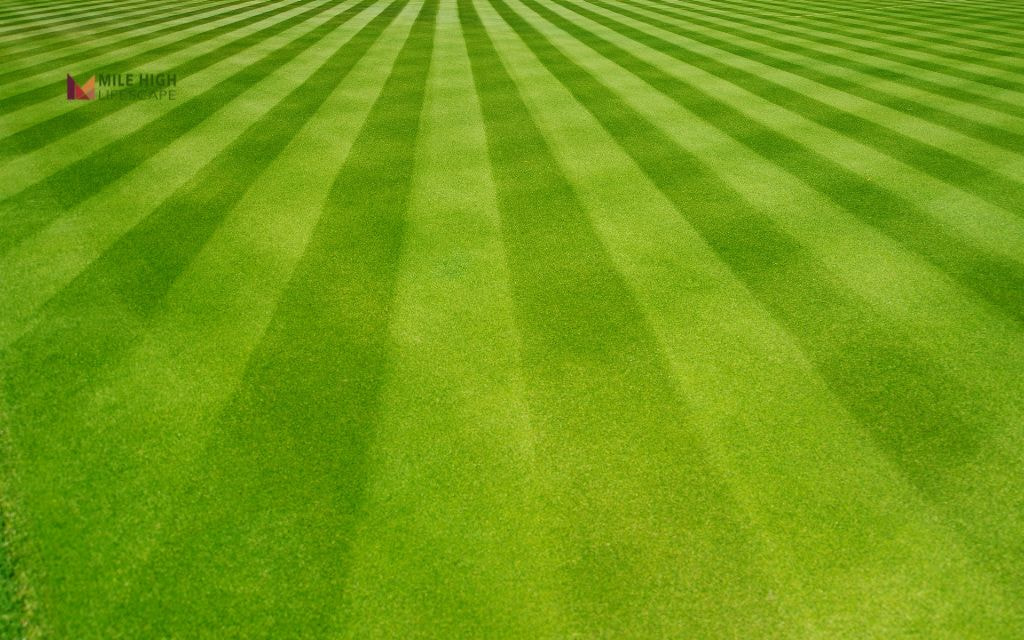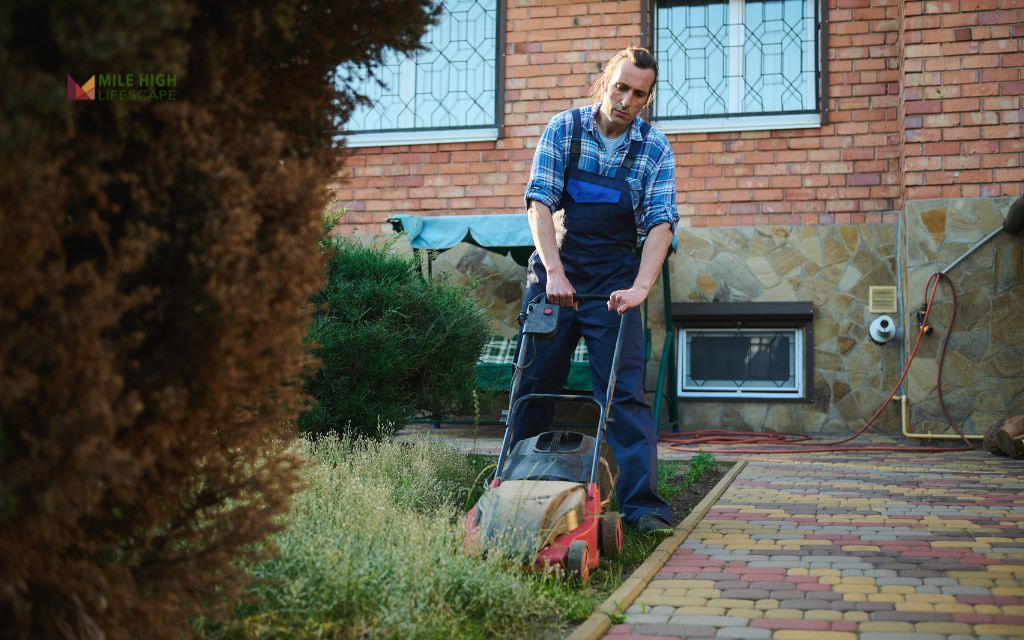Have you ever wondered exactly how long to wait to mow after lawn treatment? The timing between applying treatments and mowing determines whether your yard thrives or struggles.
Most homeowners should wait 24-48 hours after fertilizing, 48 hours after herbicide application, and 24-48 hours after pest treatments – but Denver’s unique climate can change these timeframes.
Fertilizers need time to penetrate the soil, herbicides require absorption time to eliminate weeds, and pest control products must settle to be effective. Rushing this process wastes both your investment and effort.
But how do you know when it’s safe to mow? Let’s explore the answer in this blog below!
How Long To Wait To Mow After Lawn Treatment: The Ideal Time
Mowing After Fertilization
Different fertilizers require different waiting periods before you can safely mow your lawn:
Granular Fertilizers: Wait 24-48 Hours
- These small pellets need time to dissolve into the soil
- Water your lawn after application to help them break down faster
- Mowing too soon will vacuum up the granules before they can help your grass
- For slow-release granular fertilizers, aim for the full 48 hours
Liquid Fertilizers: Wait at Least 24 Hours
- These absorb more quickly than granular types
- They still need time to dry on grass blades and move into the soil
- Mowing too soon wipes away the liquid before absorption completes
- If you’ve applied during hot weather, consider waiting the full 48 hours
Organic Fertilizers: Wait 48-72 Hours
- Natural options like compost or manure break down more slowly
- Beneficial microorganisms need time to begin the decomposition process
- These fertilizers continue working for weeks after application
- The longer waiting period ensures the initial breakdown process isn’t disrupted

Mowing After Herbicide Application
Herbicides target weeds in different ways, and each type needs specific waiting times:
Post-Emergent Herbicides: Wait 24-48 Hours
- These target weeds already growing in your lawn
- The chemical needs time to move from leaves down to the roots
- For tough perennial weeds like dandelions, wait the full 48 hours
- In Denver’s dry climate, consider waiting 72 hours for maximum effectiveness
Pre-Emergent Herbicides: Wait 48 Hours
- These create a barrier in the soil to prevent weed seeds from sprouting
- Apply to recently mowed lawns, then leave undisturbed
- Mowing too soon disrupts the chemical barrier before it forms properly
- These are best applied in early spring and fall in Denver
Selective vs. Non-Selective Herbicides
- Selective herbicides (targeting specific weeds): Wait 48 hours
- Non-selective herbicides (like glyphosate): Wait 72 hours
- Contact herbicides (work on direct contact): Wait 24-48 hours
- Always check the product label for specific manufacturer recommendations
Mowing After Pest Control Treatments
Pest treatments require patience to ensure they reach their targets effectively:
Surface Insecticides: Wait 24 Hours
- Products targeting visible pests like ants or grubs need contact time
- Mowing removes the chemical before it eliminates the pests
- For heavy infestations, consider waiting up to 48 hours
- Apply these in early morning or evening in Denver for best results
Soil-Applied Insecticides: Wait 48-72 Hours
- These need time to penetrate down to where soil-dwelling pests live
- Mowing compacts soil and disrupts this movement
- Water lightly after application to help the product move downward
- In Denver’s often sandy soils, the longer waiting period ensures proper depth
Fungicides: Wait 24-48 Hours
- These create a protective barrier on grass blades
- Mowing too soon removes this shield before it sets up properly
- For active fungal problems, wait the full 48 hours
- Apply during dry periods for best effectiveness
Weather Factors Affecting Waiting Times
Denver’s unique climate affects how long you should wait:
Temperature Considerations
- Cool weather (below 60°F): Add 12-24 hours to standard waiting times
- Hot weather (above 85°F): Add 12-24 hours as stressed grass absorbs more slowly
- Moderate weather (60-85°F): Standard waiting times apply
- Early spring or late fall applications may need extended waiting periods
Moisture Factors
- Recently irrigated lawns: Wait until completely dry after treatment before mowing
- Drought-stressed lawns: Add 24 hours to standard waiting times
- After rain: Wait until grass is completely dry, then apply treatments and observe standard waiting times
- High humidity days: Standard waiting times usually sufficient
Denver-Specific Considerations To Mow Lawn After Treatment
Seasonal Timing for Lawn Treatments in Denver
Denver’s unique climate requires adapting lawn care timing throughout the year:
- Spring (April-May) marks prime time for fertilization and pre-emergent weed control in Denver. Apply treatments, wait the full recommended time before mowing, and you’ll establish a strong foundation for the growing season.
- Summer (June-August) calls for careful timing due to heat stress. When applying treatments during summer, wait the full recommended period plus an additional 12 hours before mowing, as grass under heat stress absorbs treatments more slowly.
- Fall (September-October) provides the second major treatment window for Denver lawns. Fertilizer applied in fall needs the standard waiting period, but becomes even more effective when left undisturbed as the grass prepares for winter dormancy.
- Winter (November-March) typically doesn’t require treatments, but any late fall applications should remain undisturbed until spring growth resumes.

Weather Conditions in Denver
Denver’s weather significantly affects treatment timing:
- After rain, wait until grass completely dries before applying treatments, then follow standard waiting periods before mowing. Wet grass can cause uneven distribution of treatments.
- During drought, increase the waiting period by 50% as stressed grass absorbs treatments more slowly.
Temperature fluctuations common in Denver can extend absorption time. For each 10°F below optimal application temperature (usually 65-75°F), add 12 hours to your waiting period.
UV intensity at Denver’s elevation can degrade certain treatments more quickly. Apply treatments in the evening when possible, and still observe the full waiting period before mowing.
Common Grass Types in Denver
Different grass species in Denver respond uniquely to treatments and mowing schedules:
- Kentucky Bluegrass, Denver’s most common turf type, benefits from a full 48-hour waiting period after most treatments to maximize absorption through its dense growth habit.
- Tall Fescue, increasingly popular for its drought tolerance, generally needs the standard waiting periods but handles premature mowing better than other varieties due to its robust root system.
- Fine Fescues require careful timing and benefit from waiting an extra day beyond recommendations, as their fine leaf structure makes them more sensitive to chemical applications.
- Buffalograss, a native option for water conservation, needs standard waiting periods despite its lower maintenance requirements.
Why Timing Matters After Lawn Treatment
Patience after treatment leads to stronger, healthier grass. Those extra 24-48 hours make the difference between a thriving lawn and one that struggles despite your best efforts.
The Impact of Lawn Treatments on Grass Health
Lawn treatments require specific time to work properly. Think of it like medicine for your grass. Each type works differently:
- Fertilizers need time to dissolve and release nutrients into the soil
- Herbicides must penetrate weed tissues to stop their growth
- Pest control products require time to eliminate harmful insects and disease
When you mow too quickly after application, you interrupt these important processes.
For example, granular fertilizers sitting on top of your lawn need moisture to dissolve. Mowing too soon simply collects these granules in your lawn bag – wasting both product and money.
Most lawn treatments need 24-48 hours of contact with your grass. During this time, the active ingredients work their way into plant tissues or soil. This absorption process can’t be rushed. Cutting this time short might reduce your treatment effectiveness by half or more.
Risks of Mowing Too Soon
Mowing prematurely creates several problems for your lawn:
Physical Removal Of Treatments
When you mow too soon, your mower can physically remove treatments before they work. Studies show herbicide effectiveness can drop by 40-60% when mowing happens too quickly after application.
Stress On Your Grass
Cutting grass creates a wound that requires healing. After mowing, your lawn redirects energy to repair these cuts rather than absorbing treatments. This natural stress response prevents proper absorption of the nutrients or chemicals you’ve applied.
Increased Vulnerability
Fresh cuts on grass blades create entry points for disease. If treatments haven’t had time to strengthen your lawn’s defenses, these cuts become opportunities for fungus and other problems to take hold.
Wasted Investment
In Denver’s unique climate, premature mowing is especially wasteful. Our altitude, dryness, and temperature swings already challenge lawn health – skipping the waiting period essentially throws away the money spent on treatments.

Best Practices for Lawn Care After Treatments
Maintaining Mowing Height
Proper mowing height maximizes treatment effectiveness:
- Set your mower to 3-3.5 inches for cool-season grasses common in Denver. This height promotes stronger root development, which enhances nutrient uptake from fertilizers.
- Never remove more than one-third of the grass blade in a single mowing, especially after treatments. This prevents stress that could interfere with treatment absorption.
- Raise your mowing height during summer heat to reduce stress and improve treatment utilization.
After treatments have been absorbed, maintain consistent mowing heights to promote even growth and continued effectiveness of the applied products.
Equipment Maintenance
Proper equipment preparation ensures effective post-treatment mowing:
- Sharpen mower blades at least twice per season for clean cuts that heal quickly and don’t interfere with treatment absorption.
- Clean your mower deck thoroughly before mowing recently treated areas to prevent residue from affecting treatment distribution.
- Consider dedicating specific mowing patterns for post-treatment mowing to ensure even coverage and minimal disruption.
- Avoid mowing when soil is wet after treatments, as this can cause compaction that reduces treatment penetration to roots.
Integrated Lawn Care for Optimal Health
Coordinate all aspects of lawn care for maximum treatment effectiveness:
- Water appropriately after the recommended waiting period to help activate treatments without washing them away. In Denver’s climate, morning watering works best.
- Aerate compacted soil areas before applying treatments, then wait the standard period plus an additional day before mowing to maximize absorption through the aeration channels.
- Consider soil testing every 2-3 years to tailor treatments to your lawn’s specific needs, which improves effectiveness and may reduce necessary waiting times.
Develop a comprehensive seasonal schedule that properly spaces treatments, watering, and mowing for your specific Denver lawn conditions.
Frequently Asked Questions (FAQs)
Is it OK to mow after lawn treatment?
Yes, but only after waiting for the appropriate time. Mowing too soon can remove treatments before they work properly and reduce their effectiveness.
How long to stay off grass after lawn treatment?
Stay off treated grass for 24-48 hours. For liquid treatments, wait until completely dry (about 2-4 hours). Herbicides and pesticides may require keeping pets and children off for 72 hours for safety.
How long after fertilizing a lawn can I mow?
Wait 24-48 hours after applying granular fertilizer, 24 hours for liquid fertilizer, and 48-72 hours for organic fertilizer before mowing your lawn to ensure proper nutrient absorption.
Should I mow my lawn before or after treatment?
Mow before applying treatments in most cases. For pre-emergent herbicides and fertilizers, a freshly mowed lawn allows better contact with soil. For post-emergent weed treatments, apply first, then wait the recommended period (typically 48 hours) before mowing.
How long should I wait before mowing after pest control treatments?
Wait 24-48 hours for surface insecticides and 48-72 hours for soil-dwelling pest treatments. In Denver’s sandy soils (common in newer developments), extend to 72 hours for soil-applied pesticides to ensure proper root zone penetration.
Is it safe to mow right after watering my lawn following treatment in Denver?
No. Wait until the grass completely dries (typically 2-4 hours in Denver) after watering a treated lawn. Mowing wet, treated grass damages the turf, creates uneven treatment distribution, and increases fungal disease risk.
Conclusion
The question of how long to wait to mow after lawn treatment has a clear answer for Denver homeowners: granular fertilizers need 24-48 hours, most herbicides require 48 hours, and pest treatments typically need at least 24 hours before mowing.
Following these guidelines ensures your lawn care investments deliver maximum results rather than wasting time and money. Remember that these timeframes may extend based on Denver’s unique climate conditions, weather patterns, and your specific grass type.
If you need professional help for your lawn care, contact Mile High Lifescape at (303) 877-9091. Our experts provide tailored solutions for Denver homeowners seeking to maintain their lawn health and appearance.
